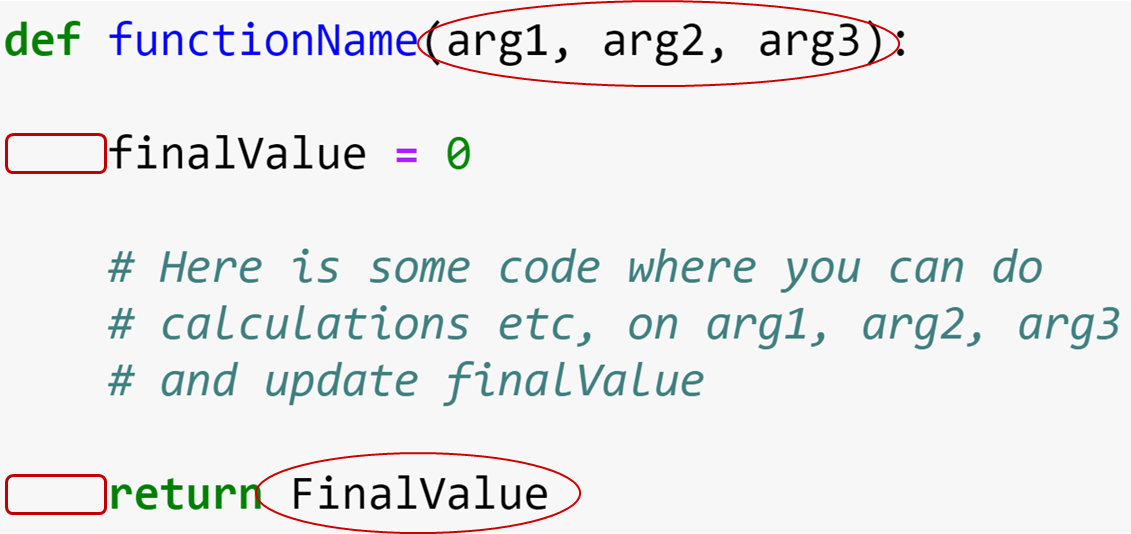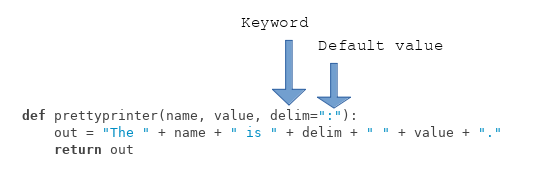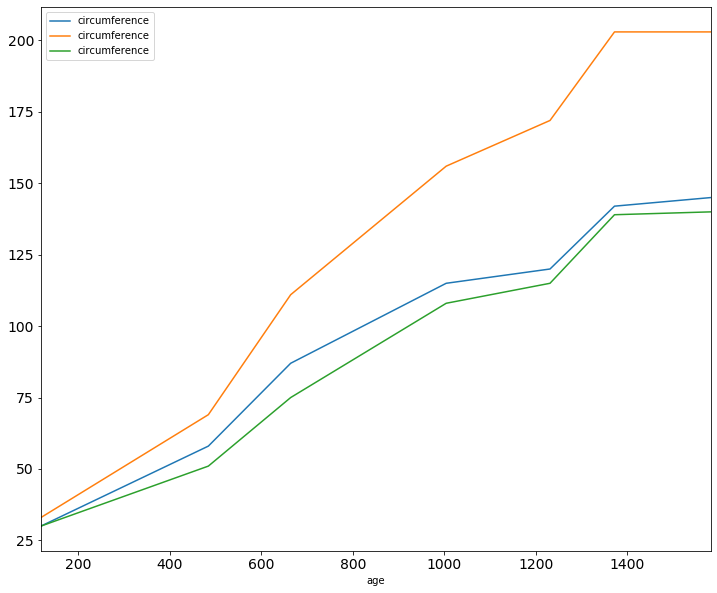Review¶
- Why does it matter what type a variable has?
- What is the difference between
'1'*2and1*2? - Is
'2' < '12'?
- What is the difference between
- How (and when) can you change the type of those? When does it not work?
- How do you make the string
'0.29'into a number?
- How do you make the string
- You have worked with a number of data containers; lists, sets, dictionaries. What is the difference between them and when should you use which?
- What is a function?
- Write a function that multiplies the input argument by 2.
Review¶
- Why does it matter what type a variable has?
Values of different types stores different types of information.
Different types can be used with different operations, functions and methods.
1+2
"1"+"2"
"1"+2
"1"*2
Take extra care when comparing values
2 < 12
"2" < "12"
Review¶
- How can you change (convert) the type of a value? When does it not work?
float("1")
int("1")
str(1)
int("2.2")
Converting between strings and lists
list("hello")
str(['h', 'e', 'l', 'l', 'o'])
''.join(['h', 'e', 'l', 'l', 'o'])
Review¶
- You have worked with a number of data containers; lists, sets, dictionaries. What is the difference between them and when should you use which?
- lists: when order is important
- dictionaries: to keep track of the relation between keys and values
- sets: to check for membership. No order, no duplicates.
mylist = ["comedy", "drama", "drama", "sci-fi"]
myset = set(mylist)
print('All genres', myset)
mydict = {"genre": "drama", "title": "Toy Story"}
Review¶
- What is a function?
A named piece of code that performs a specific task.
A relation between input data (arguments) and a result (output data).
Function structure¶

- The
defkeyword
- Arguments
- Indentation!
return
Multiply by two¶
def multiply_by_two(x):
return x*2
multiply_by_two(2)
def multiply_by_two(x):
print(x*2)
multiply_by_two(2)
Multiply by two - return values¶
def multiply_by_two(x):
return x*2
result = multiply_by_two(2)
print('Result', result)
def multiply_by_two(x):
print(x*2)
result = multiply_by_two(2)
print('Result', result)
def multiply_by_two(x):
x*2
res = multiply_by_two(2)
print('Result', result)
TODAY¶
- Loops and functions, code structure
- Pandas - explore your data!
Common concepts¶
Scope
a
def myfunc(a, b):
print(a)
a
a = 5
def myfunc(a):
a += 2
return a
b = myfunc(8)
a, b
The local a in myfunc shadows the global a.
The variables inside functions are local. To avoid confusion, use different variable names.
global_a = 5
def myfunc(value):
value += 2
return value
result = myfunc(8)
global_a, result
No confusion!
myfunc has unique variable names.
Return values
def multiply_by_two(x):
return x*2
result = multiply_by_two(2)
print('Result', result)
def multiply_by_two(x):
print(x*2)
result = multiply_by_two(2)
print('Result', result)
def multiply_by_two(x):
x*2
res = multiply_by_two(2)
print('Result', result)
None¶
What is None? Why?
When is it used?
- What is it?
- A keyword with a constant value (like
True,False) Null
- A keyword with a constant value (like
- Why and when?
- To signal "emtpy values"
- Variables with no values yet
- Functions that don't return anything meaningful
Comparing None¶
value = None
if value is not None:
print('value is something')
else:
print('no value!')
None == True
None == False
Comparing None¶
myvalue = None
if myvalue > 10:
print('Big value')
myvalue = None
if myvalue is not None and myvalue > 10:
print('The value is not None')
else:
print('The value is None')
Exercise A¶
Write a function that takes one argument called value.
- If
valueis not None and if it is greater to or equal to 10, the function should print "big number". - If it is not None, and if it is between 0 and 10, the function should print "small number".
- Otherwise, the function should print "No number".
def tester(value):
if value is not None and value >= 10:
print("big number")
elif value is not None and 0 < value < 10:
print("small number")
else:
print("No number")
tester(11)
tester(3)
tester(None)
Keyword arguments
open('../files/250.imdb', 'r', encoding='utf-8')
def prettyprinter(name, value, delim=":"):
out = "The " + name + " is " + delim + " " + value + "."
return out
- Programmer can set default values

prettyprinter("title", "Movie")
- User can ignore the arguments (default value is used)
def prettyprinter(name, value, delim=":"):
out = "The " + name + " is " + delim + " " + value + "."
return out
prettyprinter("genre", "Drama", delim="=")
prettyprinter("genre", "Drama", "=")
def prettyprinter(name, value, delim=":", end=None):
out = "The " + name + " is " + delim + " " + value
if end:
out += end
return out
my_str = prettyprinter("title", "Movie")
print(my_str)
prettyprinter("genre", "Drama", "=", ".")
prettyprinter("genre", "Drama", end="!", delim="=")
open(file, mode='r', buffering=-1, encoding=None, errors=None,
newline=None, closefd=True, opener=None)
- Gives better overview
open('../files/250.imdb', 'r', encoding='utf-8')
open('../files/250.imdb', mode='r', encoding='utf-8')
open('../files/250.imdb', encoding='utf-8', mode='r')
Keyword arguments¶
- programmer: set default values
- user: ignore arguments
- better overview
Exercise B¶
Rewrite the function from previous exercise, so that it takes one keyword argument, value. The default value of this argument is None.
- If
valueis not None and if it is greater to or equal to 10, the function should print "big number". - If it is not None, and if it is between 0 and 10, the function should print "small number".
- Otherwise, the function should print "No number".
def tester(value=None):
if value is not None and value >= 10:
print("big number")
elif value is not None and 0 < value < 10:
print("small number")
else:
print("No number")
tester(11)
tester(3)
tester()
Controlling loops - break
for x in lines_in_a_big_file:
if x.startswith('>'): # this is the only line I want!
do_something(x)
...waste of time!
for x in lines_in_a_big_file:
if x.startswith('>'): # this is the only line I want!
do_something(x)
break # break the loop

Controlling loops - continue
for x in lines_in_a_big_file:
if x.startswith('>'): # this is a comment
# just skip this! don't do anything
do_something(x)
for x in lines_in_a_big_file:
if x.startswith('>'): # this is a comment
continue # go on to the next iteration
do_something(x)
for x in lines_in_a_big_file:
if not x.startswith('>'): # this is *not* a comment
do_something(x)

Exercise 1¶
pick_movie(year=1996, rating_min=8.5)
The Bandit
pick_movie(rating_max=8.0, genre="Mystery")
Twelve Monkeys
→ Notebook Day_4_Exercise_1
A short note on code structure¶
- functions
- modules (files)
- documentation
Why modules?¶
- Cleaner code
- Better defined tasks in code
- Re-usability
- Better structure
- Collect all related functions in one file / module
- Import a module to use its functions
- Only need to understand what the functions do, not how
Python standard modules¶
Check out the module index
How to find the right module?
How to understand it?
How to find the right module?
- look at the module index
- search PyPI
- ask your colleagues
- search the web!
How to understand it?
import math
help(math)
help(math.sqrt)
math.sqrt(3)
Importing¶
import math
math.sqrt(3)
import math as m
m.sqrt(3)
from math import sqrt
sqrt(3)
Documentation and commenting your code¶
Remember help()?
Works because somebody else has documented their code!
def process_file(filename, chrom, pos):
for line in open(filename):
if not line.startswith('#'):
columns = line.split('\t')
if col[0] == chrom and col[1] == pos:
print(col[9:])
?
def process_file(filename, chrom, pos):
"""Read a vcf file, search for lines matching chromosome chrom and position pos.
Print the genotypes of the matching lines.
"""
for line in open(filename):
if not line.startswith('#'):
columns = line.split('\t')
if col[0] == chrom and col[1] == pos:
print(col[9:])
help(process_file)
Your code may have two types of users:
- library users
- maintainers (maybe yourself!)
Write documentation for both of them!
- library users:
"""What does this function do?"""(doc strings) - maintainers:
# implementation details(comments)
Documentation:¶
At the beginning of the file
"""This module provides functions for..."""
Comments:¶
my_list[5] += other_list[3] # explain why you do this!
Formatting¶
title = 'Great movie'
rating = 10
print('The result is: '+ title + 'with rating: ' + rating)
Formatting!¶
print('The result is: {} with rating {}'.format(title, rating))
Formatting - f-strings¶
print(f'The result is: {title} with rating {rating}') # python version >= 3.6
Formatting - the old way¶
print('The result is: %s with rating %s' % (title, rating)) # python2
Formatting¶
f'some text {variable:^50} text' # center in a 50 character wide column
f'some text {variable:<50} text' # left align in 50 character wide column
f'some text {variable:.2f} text' # round a float to 2 digits
Learn more from the Python docs: https://docs.python.org/3.4/library/string.html#format-string-syntax
Exercise 2¶
→ Notebook Day_4_Exercise_2
Pandas¶
Library for working with tabular data
- comma separated (csv)
- tab separated (tsv)
- ...
Data analysis, graph plotting...
Pandas¶
| circumference | height | |
|---|---|---|
| age | ||
| 1 | 2 | 30 |
| 2 | 3 | 35 |
| 3 | 5 | 40 |
| 4 | 10 | 50 |

Pandas - a short overview¶
import pandas as pd
help(pd)
tree_growth = pd.read_table('../downloads/Orange_1.tsv', index_col=0)
Dataframes¶
tree_growth
- One index (in this case
age) - A bunch of colums (in this case
circumferenceandheight) - A bunch of rows (identified by their index)
tree_growth.columns
tree_growth.index
Exploring the data - picking a column¶
tree_growth.circumference
dataframe.columnname
dataframe['columnname']
tree_growth.height
tree_growth.circumference.max()
Exploring the data - picking a row¶
tree_growth.loc[4]
dataframe.loc[row_name]
Reading data¶
dataframe = pandas.read_table(filepath, index_col=N)
dataframe.columnname
dataframe.loc[row_name]
Exercise 3¶
- Read the
Orange_1.tsv - Print the height column
- Print the data for the tree at age 2
tree_growth = pd.read_table('../downloads/Orange_1.tsv', index_col=0)
tree_growth
tree_growth.height
tree_growth.loc[2]
Many trees!¶
Orange.tsv
Tree age circumference
1 118 30
1 484 58
1 664 87
1 1004 115
...
2 118 33
2 484 69
...tree_growth = pd.read_table('../downloads/Orange.tsv', index_col=0)
tree_growth
tree_growth.index
tree_growth.columns
tree_growth.age
tree_growth.age.values
tree_growth.age.unique()
Works like a normal list:
tree_growth.age.unique()[0]
Selecting parts of the table¶
tree_growth.circumference # selecting a column
tree_growth.loc[2] # selecting rows with index 2
tree_growth.loc[ criteria ] # select all rows that fullfills this criteria
Selecting parts of the table¶
Find the data points where the tree is younger than 200 years!
- Find rows => use
tree_growth.loc[]
- Select these based on the value of column age =>
tree_growth.age
# The answer...
young = tree_growth.loc[tree_growth.age < 200]
young
Exercise 4¶
- Read the data
Orange.tsv - Find the maximum circumference
- What tree reached that circumference, and how old was it at that time?
tree_growth.loc[ tree_growth.age < 200 ]
import pandas as pd
tree_growth = pd.read_table('../downloads/Orange.tsv',index_col=0)
max_c = tree_growth.circumference.max()
print(max_c)
tree_growth.loc[tree_growth.circumference == max_c]
Plotting¶
df.columnname.plot()
orange_1 = pd.read_table('../downloads/Orange_1.tsv')
orange_1.circumference.plot()
Plotting¶
What if no plot shows up?
%pylab inline # jupyter notebooks
or
import matplotlib.pyplot as plt
plt.show()
Plotting - many trees¶
- Plot a bar chart
tree_growth.plot(kind='bar')
tree_growth.plot(kind='bar', figsize=(12, 12), fontsize=12)
Plotting¶
- Plot a line graph
# Starting with tree number 1
tree1 = tree_growth.loc[1]
tree1
Plotting¶
- Plot a graph:
dataframe.plot(kind="line", x=..., y=...)
tree1.plot(x='age', y='circumference', fontsize=14, figsize=(12,10))
Plotting¶
- Plot a graph:
dataframe.plot(kind="line", x="..", y="...")
Let's plot all the trees!
tree_growth.plot(kind='line', x='age', y='circumference', figsize=(12, 10), fontsize=14)
:(
Plotting¶
- Plot a graph:
dataframe.plot(kind="scatter", x="..", y="...")
tree_growth.plot(kind='scatter', x='age', y='circumference', figsize=(12, 10), fontsize=14)
Plotting¶
What about the lines?
- Group the table by the index (make subtrees / subdataframes)
- Get one board to plot all the lines
- Draw them one by one
dataframe.groupby([what])
import matplotlib.pyplot as plt
fig, ax = plt.subplots()
Plotting¶
import matplotlib.pyplot as plt
fig, ax = plt.subplots()
for index, subtree in tree_growth.groupby(['Tree']):
subtree.plot(x='age', y='circumference', ax=ax, kind='line', fontsize=14, figsize=(12,10))
Exercise 5¶
- Use Pandas to read IMDB
- Explore it by making graphs
